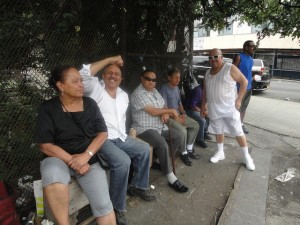
On a late summer evening a crowd of fifty-and-sixty-something Latinos and Latinas gathered to unwind over drinks, cards, and dominoes.
Nearby, under a tree made to resemble a palm tree, a DJ spun classic salsa with a few reggaeton songs mixed in. A vendor prepared alcapurrias, a Puerto Rican delicacy made from fried smashed yucca or green bananas filled with seasoned meat, along with other cuchefritos, or fried appetizers.
All around, new construction projects were going up, including a towering silver complex with new condos. In their shadows, the 55-and-over crowd had come to relax.
What seemed like a scene out of a flourishing Florida retirement community was in fact the intersection of Brook Avenue between 156th and 157th in Melrose.
The men and women who gather here call their sliver of sidewalk Villa Cuerno, translated as “village of horns.”The name harks back to a steamy past, the details of which vary depending whose interpretation you hear.
“I come here every weekend,” said 63-year-old Jose Santoviey as he sat with four friends on a makeshift wooden bench.“In Puerto Rico you go out into the streets to socialize and enjoy. It feels like Puerto Rico here.”
The loose-knit group of friends, which still numbers about 30, has been kicking back at this street corner on spring and summer weekends for decades, but now finds its longevity threatened by the heated local housing boom.
Long before the Melrose Court Condos were built in the mid 1990’s, the space the buildings now occupy was an empty dirt lot, recalled Altagracia Ozuna, 40, the group’s youngest member. Residents had built shacks and stores on the lot in the early ’80’s and dubbed the small shantytown Villa Alegre, or happy village.
Players from local softball teams and other residents started coming to Villa Alegre to drink and listen to live Latin music back then. Even Latin jazz legend Eddie Palmieri once graced a makeshift stage on the field, recalledOzuna.
But the happy village’s reputation soured. Members of the softball teams would get drunk. There were frequent trysts in an outhouse on the grounds. Soon Villa Alegre became Villa Cuerno, cuerno referring to devil’s horns in colloquial Spanish.
The fire department came and condemned Villa Cuerno. The pejorative name stuck. But the group stayed together, moving around frequently before settling back near their original spot.
Many recall the glory days of Villa Cuerno when the party would last until 3 a.m.
While the rendezvous have diminished, there is still plenty of flirting among the group members, many of whom are grandma’s and grandpa’s. Some walk with the aid of canes.
Grandchildren of regulars occasionally come to visit, but young people are not a part of Villa Cuerno.
“There’s no young people because they fight, do drugs, they bullshit. Here we are about family,” said Santoviey angrily. “Here we relax. We talk about family, about Puerto Rico.”
In recent years the group has kept a low profile, but Villa Cuerno regulars worry that tenants from the newly built Via Verde and Procida Houses complexes will want them out.
“This is the last year,” said one woman.
Azuna suggested they could merge with the nearby community garden Rincon Criollo, and use their base as a future hangout but, Rincon’s founder Jose “Chema” Soto worries about clashing objectives.
“We are a garden culture, fruits and plants. Over there they sell beer. That’s a place of business. I just don’t want that in here,” said Soto.
While there is a sense that this my be Villa Cuerno’s last year in its current location, some, like 63-year-old Edwin Ayala, remain defiant.
“While we are still alive we will be here. This was and is my life,” said Ayala. “This is where I left my wife and this is where she left me.”

The name “Villa Cuerno” was created by my late grandmother. The woman on which the elders know her as “La Negra” her real first name: Isabel. Ask anyone. She created that spot. Her spirit made it the place where people would gather and share stories and live happy. Through food, drinks, and jokes. She was the life of that place.